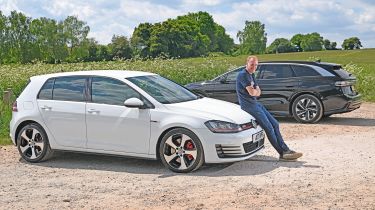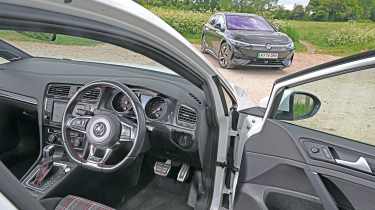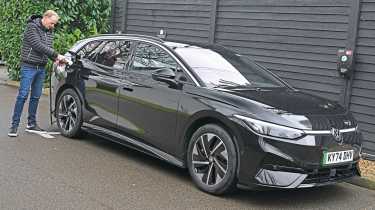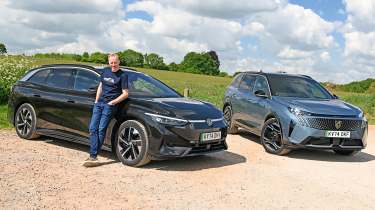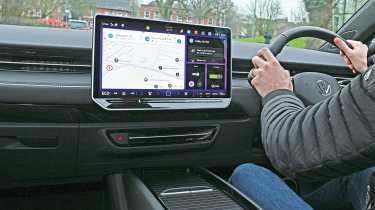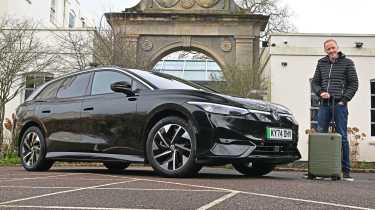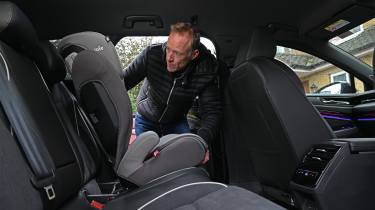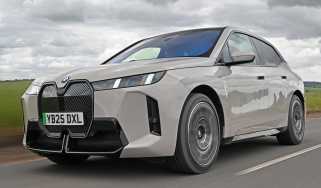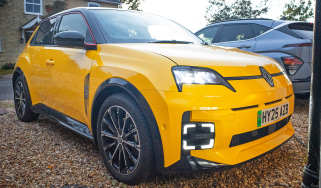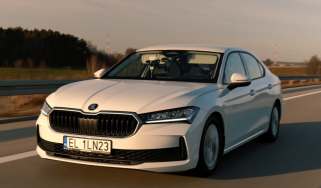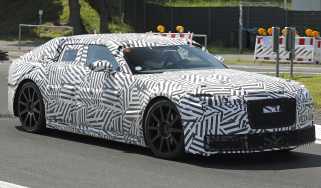Volkswagen ID.7 Tourer Pro S Match long-term test: a people’s car for the electric age
Final report: Our man owns an iconic VW, so how does his EV compare?

Verdict
The VW ID.7 is a true ‘people’s car’ with good practicality, performance and efficiency at a reasonable price. We love the spaciousness, comfort and long range, but there are lots of niggles that VW must iron out, especially the brakes. Even so, if you need an electric estate, this is definitely worth considering.
- Mileage: 5,012 miles
- Efficiency: 3.6 miles/kWh
After six months and 5,012 miles, Volkswagen’s flagship electric car, the ID.7 Tourer Pro S, is departing Auto Express’s fleet. But only once I’ve assessed it through the lens of peak Golf GTI: my 2017 hatch built just before VW introduced digital dials and driver- assistance systems in the ‘Mk7.5’ version.
What DNA do these people’s cars share? Performance, comfort and great packaging at decent prices, I reckon. Using Auto Express’s Buy A Car service, VW Swindon offered me a similarly specced ID.7 Tourer for £54,276, some £3,000 off list. That’s good value for a 5m-long EV with an 86kWh battery that comfortably despatched 250-mile-plus runs from Newcastle, Wales and Blackpool to my home near London without a charging stop.
Sure, the 3.6 miles per kWh efficiency we averaged is middling for a modern EV. But the ID.7 weighs 2.1 tonnes: my Golf weighs 845kg less and measures almost 700mm shorter. Obviously the ID doesn’t have the GTI’s jinking agility, but swing the stately steering to set it up for sweeping corners and the ID grips well as the body rolls gently. Mid-corner, you can swiftly get on the power: the 282bhp rear motor provides a strong rush of mid-range torque and the EV’s 6.7-second 0-62mph sprint is barely slower than the Golf’s.
In my first few reports, I moaned about the ID’s soggy brake pedal in D mode. But reader Philip Grohmann suggested I switch to B mode, which is sharper and boosts regeneration. Rival EVs still blend regenerative and friction brakes with more reassurance, though.
Both VWs are incredibly well packaged. The ID.7 has limo-like levels of rear legroom, loads of headspace and a massive 605-litre boot. The acid test was nailing our annual music festival trip, with the boot swallowing a six-person tent, clothing for schizophrenic weather, provisions and four camping chairs. I wish VW would design a cargo cover that follows its runners and doesn’t snap open with the ferocity of a great white shark, though.
The external door handles were even more likely to bite your fingers when the keyless entry refused to engage, while the tiny unlock pad makes them unusable in the dark: total redesign needed, VW. Such ergonomic issues – air vents operated by touchscreen, one set of switches for front/rear windows – are well documented on VW’s electric cars, but there’s no such nonsense on my largely analogue GTI.
I wish it had the ID’s manoeuvring camera, which made daily driveway five-point turns easy, though; it’s just a shame there isn’t a shortcut to bring up the cameras. Shout out to the standard head-up display too, which flashes up lane markings if you stray near the edge.
But the ID’s most endearing quality is its comfort and refinement. Sometimes that mass bellyflops into dips, but the ride is mostly very cushy. And the rolling refinement, on plump, 19-inch Continental EcoContacts, is lovely and much quieter than the GTI’s Goodyears. I’ll miss the massage seats on long trips too.
If you’re after a soothing electric estate, the ID.7 should be on your list. With my GTI, it’s a two-car garage for every mood and eventuality.
Volkswagen ID.7 Tourer Pro S Match: third fleetwatch
It may lack the drama, but the Volkswagen ID.7 quietly outclasses the big E-5008 SUV
Behold the battle of the £50k niche EVs: my Volkswagen ID.7 estate vs snapper Pete’s Peugeot E-5008. Both ride comfortably, are quiet and have bags of practicality. I prefer the Peugeot’s sharp steering and punchier brakes, but otherwise the ID.7 wins dynamically: it’s 191kg lighter, which means less roll and lumbering weight transfer. And the Peugeot feels slow: 0-62mph in 9.7secs is EV walking pace. If you don’t need seven seats, pick the VW.
Volkswagen ID.7 Tourer Pro S Match: second report
Fitting a homecharger makes electric car life easy – and delightfully cheap
- Mileage: 4,685 miles
- Efficiency: 3.5 miles/kWh
Charging is the biggest hurdle to switching to an electric car, I reckon. So just after the VW ID.7 Pro S arrived, I began looking for a home EV charger for my new house, plumping for an Ohme ePod.
At £949 (including installation), it’s £50 cheaper than Ohme’s Home Pro wallbox with its digital monitoring screen and built-in cable for convenience. But I went for the more compact ePod because I didn’t want the eyesore of cable spaghetti coiled round it, and the screen is unnecessary when you can set up an automatic charging schedule via the ID.7’s touchscreen. Get home, plug in and forget about it.
BP Chargemaster fitted my last wallbox in 2019, and things have seriously progressed since. That unit was ‘dumb’, which means it lacked connected smart charging, and Chargemaster had to do a preparatory site visit. This time I just used the Ohme app to upload a scribbled house plan showing the electricity smart meter, cabling and proposed wallbox, and shot an illustrative video.
On the day, the EVs Made Easy installers lived up to the company’s name. Zuriel fitted the ePod while Tom installed the fuse board in my meter cupboard, earthed everything and hung the power cable along my alley wall.
The 32-amp charger has built-in load balancing, so if it and other high-draw appliances such as the dishwasher, tumble drier and more approach my house’s 100-amp max, it can reduce power to the car.
And there’s a circuit breaker just in case. My electricity supply was off for just 15 minutes and the whole installation took three hours: a tip-top experience from beginning to end.
The trickiest part was getting the VW, Ohme and Octopus apps to pair, with a few failed attempts in a confusing process before I triggered the Intelligent Octopus Go EV tariff. I’m now getting dirt-cheap, 7p per kWh electricity for six hours per night. And if my car’s plugged in at other times, Ohme smart charging monitors when low energy demand means prices are cheap and adds juice then.
I smugly look at the app to see one charge is said to have put 41.7kWh into the ID.7 for just £4.72, with a couple of quid saved. Since installation, the app reckons the VW has drawn 639kWh (enough to fill the 86kWh battery 7.5 times) for £76.33. Very rough man maths, but if I get about 250 miles per full battery, that’s around 4p per mile – cheaper than any ICE car.
Aside from low running costs, what else do I love about the ID.7? Its big-car space still delights. My five-person household does not pack light, but the estate car easily swallowed our Easter road trip’s suitcases, provisions and coats under the tonneau cover. And folding the seats creates a low-roof van that aces trips to the recycling centre.
Niggles? The recessed door handles can refuse to open, with the springy flap sometimes jarring my fingertips: irritating software mission creep! But the brakes are the ID.7’s Achilles’ heel; the pedal responds inconsistently, often feels horribly spongy and can travel disconcertingly far before the pads start to slow the car.
It’s not easy for automotive engineers to tune a progressive blend between electronic regeneration and the friction brakes. That’s the price I’m paying for those low EV running costs, I suppose.
Volkswagen ID.7 Tourer Pro S Match: second fleetwatch
The VW ID.7 Tourer's eye-catching range figures mean long trips can be performed without charging en-route
Three factors temper EV demand: vehicle range, the recharging network and affordability. The Volkswagen ID.7 Tourer has piled on miles recently, with return trips from London to Sunderland, Blackpool and Llandudno. Four of those minimum 220-mile journeys were done without a charge en route, at an average of 3.7mi/kWh. Just one snafu, when I had to head to a McDonalds for a top-up. Conclusion? The range argument against EVs is done. Onto the next two…
Volkswagen ID.7 Tourer Pro S Match: first fleetwatch
The VW ID.7 Tourer provides a masterclass in overcomplicating the simplest tasks
The functionality of VW’s ID cars gets criticised for good reason. The voice assistant rarely responds to prompts or the steering wheel button, and when asked to navigate to Heathrow Terminal 2 short stay, it kept offering local car parks. To open a window, you must select ‘front’ or ‘rear’ operation, using the screen to alter the air vents is nuts, and finding the keyless entry pad in the dark is tricky. Progress? You must be joking.
Volkswagen ID.7 Tourer Pro S Match: first report
Large electric estate faces its toughest test yet: family life
- Mileage: 1,977 miles
- Efficiency: 3.2 miles/kWh
There’s a small but discerning bunch of car buyers who wouldn’t have anything but an estate car. So when Volvo UK stopped selling wagons for a year, it didn’t migrate their buyers into SUVs, it just lost them to other brands.
Big estate cars with electric power is a niche within a niche, one the German brands are just beginning to fill. Volkswagen’s ID.7 Tourer is the size of an aircraft carrier, which would probably be easier to manoeuvre on my wide driveway – five-point turns are common.
I’m not complaining, because big equals bountiful space inside. My three daughters have moaned about being crammed into our Golf GTi for the past six months, but now they can stretch out their legs and pack the footwell with half of their toy collection.
Thank all that metal between the wheels for that, with Volkswagen dragging the ID.7’s windscreen pillar right up to the front wheel, creating stubby-nosed proportions to horrify luxury car designers. I actually think the ID.7 looks pretty sleek despite being quite tall for an estate. The arcing silver roof strip disguises the height and the curved rump is far from boxy.
Nonetheless, it harbours a mighty long boot, which offers a capacity of 605 litres – before dropping the 60:40-split rear bench. There are four hooks to snag shopping bag handles, and a false floor under which you can stow charge cables. It would help if the false floor could be folded as a partition to stop items getting marooned by the bulkhead, though. And I’m not keen on the shoebox-sized recesses at the sides that items tend to topple into.
So far, the luggage required for packing the kids off to the grandparents or a short anniversary break at Sopwell House in Hertfordshire has not taxed the boot. Our summer festival trip will be the acid test.
The ID.7 range is gloriously simple. You basically get a well equipped car with either a hatchback or (for £690 more) estate body, with price differences mostly down to battery size and whether you fancy the four-wheel-drive GTX performance line.
The entry-level Tourer Pro (£52,270) packs a 77kWh battery with a claimed 384 miles of range. Our £56,170 Pro S has an 86kWh pack that’s supposedly good for 424 miles, and the maximum DC charging speed is uprated from 175kW to 200kW.
Both models have a 210kW (282bhp) electric motor and instant, meaty torque that shoots the ID.7 down the road. Official consumption is 4.4 miles per kWh, although we got a respectable 3.5 on a cruise to Essex, flattered by long stints in 50mph restricted sections.
Match trim has all the essentials, including a 15-inch touchscreen with Discover Pro navigation and both wireless Apple Carplay and Android Auto connectivity, multizone climate control and keyless entry. There are also seats upholstered in lustrous-feeling microfleece, with heating and massage functions up front.
We’ve ticked two options. The Exterior Pack Plus (£1,000) adds adaptive damping, variable ratio ‘progressive steering’ and insulated rear glass. The Interior Pack (£2,000) brings a cargo net, Harmon Kardon audio, ventilated front seats with memory function, heated rear seats and additional ambient lighting shades – my daughter Florence picked pink for the fascia strips and purple downlighting.
I just wish I’d added the £2,100 glass roof to brighten up the interior. And it’s a good job winter is receding, because an efficiency-boosting heat pump costs £1,150.
| Rating: | 4.0 |
| Model tested: | Volkswagen ID.7 Tourer Pro S Match |
| On fleet since: | February 2025 |
| Price new: | £56,170 |
| Powertrain: | 86kWh battery, 1 x e-motor, 282bhp |
| CO2/BiK: | 0g/km/2% |
| Options: | £1,000 Exterior Pack Plus, £2,000 Interior Pack |
| Insurance*: | Group: 38 quote: £960 |
| Mileage/Efficiency: | 5,012 miles/3.6 miles/kWh |
| Any problems? | None so far |
*Insurance quote from AA (0800 107 0680) for a 42-year-old in Banbury, Oxon, with three points.

